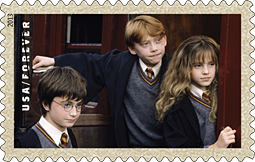 |
Collect the first 176 Years of United States Stamps! Click here to get started!
|
2013 USPS Stamp IssuesLearn everything you need to know about First Day Covers and how to order them by visiting our First Day Covers page including an updated First Day Cover Ordering Calendar, complete with ordering addresses and deadlines. TBD = To Be Determined; PSA = Pressure-sensitive Adhesive; A Forever stamp is always equal in value to the current First-Class Mail one-ounce rate when used on a one-ounce envelope. Stamp Issues:
|
|
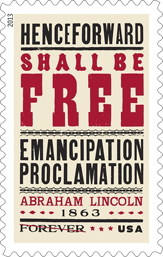 |
Emancipation Proclamation (45¢ Forever) On January 1, 1863, President Abraham Lincoln signed the Emancipation Proclamation, which declared that all slaves in the rebel states of the Confederacy "are, and henceforward shall be free." The 2013 stamp commemorates the 150th anniversary of the Emancipation Proclamation and emphasizes the powerful statement, "Henceforward Shall Be Free," on a design similar in style to the broadsides from the Civil War era. It is part of a civil rights set being issued in 2013. According to many historians, only the Declaration of Independence and the Constitution of the United States have had as great an impact on human life and liberty for so many. One provision of the proclamation authorized enlisting African Americans in the Union army. Some 180,000 blacks subsequently joined the army, and nearly 40,000 gave their lives.
|
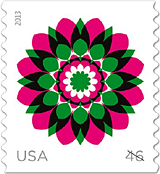 |
Kaleidoscope Flowers [Click to see 4 designs] Stamps picturing flowers are among the most popular subjects used by mailers. Designed through the application of modern computer graphics, these new Flowers stamps are reminiscent of kaleidoscope flowers and their changing colors. The set of four depicts the same contemporary flower drawing, with each stamp featuring one of four different color combinations. Some of the color combinations create the illusion that patterns recede or come forward, giving the stamps a dramatic visual appeal. These stamps are expected to be denominated 46¢, the First Class rate being sought by the USPS. |
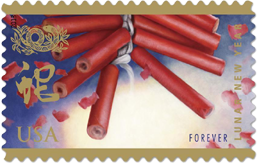 |
Lunar New Year: Year of the Snake [Click to see sheet] The USPS will welcome the New Year with a bang—in the form of a bundle of firecrackers—colored red for good fortune—on its 2013 Lunar New Year (Year of the Snake) stamp. The Chinese character for "Snake," drawn in grass-style calligraphy, is seen on the left side of the stamp, which is being issued as a Forever ® stamp in self-adhesive sheets of 12. The Year of the Snake begins on February 10, 2013, and ends on January 30, 2014. People born during the Year of the Snake are said to be deeply philosophical, mysterious, and comfortable being alone. The Lunar New Year is celebrated in various ways, inluding the use of firecrackers to scare off evil spirits and welcome a time of renewed hope. |
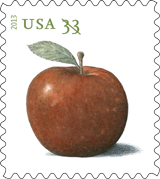 |
Apples [Click to see 4 designs] To meet the new 33¢ Postcard rate, the U.S. Postal Service turns to apples, described by the Postal People as “not only good—and good for you—but they're also delightful, cheery stamp subjects, just right for postcards!” Some of America's favorite varieties of this popular fruit are shown in these four stamps: the bright-red Baldwin, the green Granny Smith, the yellow Golden Delicious, and the multi-colored Northern Spy. Juicy and aromatic Baldwin apples are delicious when eaten in season—fresh, cooked, or in baked goods—and are prized by makers of cider. “Spies are for pies!” is a reminder that generations of cooks have found the Northern Spy apple delicious when baked in desserts, cider and juice—and today scientists believe this apple, loaded with vitamin C and antioxidants, may be one of the best at keeping the doctor away. The Golden Delicious apple, named for its yellow-gold skin and sweet flavor, is an excellent all-round apple, makes a purée good for use in baby foods and is said to make the best apple butter! The tart, green Granny Smith apple is one of the world's most well-known varieties. Its pleasingly sour flavor and crisp texture makes this juicy apple good for cooking or eating fresh. |
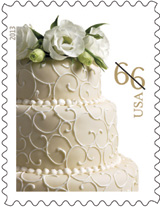 |
Wedding Cake This 66¢ Wedding Cake stamp uses the same design as the 2009 61¢ Wedding Cake stamp, which has been reissued multiple times since then with each 2-ounce rate increase. It is part of an ongoing series of issues that can be used to mail Wedding invitations. The 66¢ stamp can be used on the outer envelope, which contains the Wedding invitation, an RSVP card, and an RSVP envelope on which the 2011 Wedding Roses Forever First Class rate stamp can be used. Pastry chef Peter Brett created and designed the cake. Art Director Ethel Kessler incorporated it into her stamp design
|
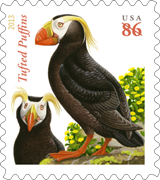 |
Tufted Puffins With tufts of bright yellow feathers springing from its head, the tufted puffin looks like a clown to some and a punk rocker to others. Two of these unmistakable sea birds appear on the Tufted Puffins stamp, depicted during breeding season when their signature yellow plumage appears. Tufted puffins can be found along the Pacific coast from Oregon to Alaska. They hunt underwater, diving as deep as 200 feet and using their wings to propel themselves through the water. True creatures of the sea, they even eat underwater, and spend much of their lives on the open ocean. Art director Derry Noyes designed the stamp, which features a painting by artist Robert Giusti. |
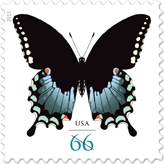 |
Spicebush Swallowtail Butterfly The spectacular spicebush swallowtail butterfly is featured on the third butterfly stamp for use on large greeting card envelopes and other envelopes with irregular sizes and shapes. Both as caterpillars and adults, spicebush swallowtails hide from their predators in plain sight by mimicking other animals and even inedible objects, at various stages resembling a bird dropping, a small green snake with yellow and black markings that resemble a snake's eyes and a false forked tongue, and a dried brown leaf complete with veins. Like so much that is created on a computer, the result of the design work for this stamp is not an exact replica of a spicebush swallowtail, but a highly stylized, simplified version. |
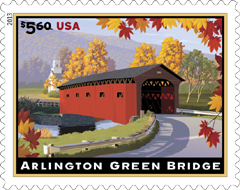 |
Arlington Green Bridge The scenic Arlington Green Bridge in Bennington County, Vermont, takes center stage in this Priority Mail stamp. One of the most-photographed covered bridges in the state, it was built in 1852. The digital stamp art presents an idyllic version of the red wooden bridge against a backdrop of autumn leaves. On the far side of the bridge, a white church steeple rises from a traditional village green. The bridge spans the Batten Kill trout stream in Arlington, just off Route 313 in southern Vermont. Stretching 80 feet across the stream, the bridge's roadbed is only wide enough to allow one lane of traffic at a time to rumble over its wooden planks at a time. |
 |
Global Forever Building on the success of its domestic First-Class Letter Rate Forever stamps, the USPS now introduces a Global Forever international rate stamp that pays the rate ($1.10 in 2013) for any First-Class Mail International 1-ounce letter to any country in the world, and up to a 2-ounce letter to Canada. The stamp features a rendering of Earth composed of images created from satellite data and redesigned with 3D computer technology. In keeping with the globe design, the shape of the stamp also is round. Greg Breeding designed the stamp. |
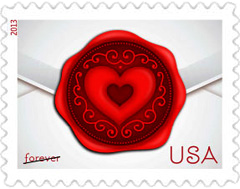 |
Sealed with Love The 2013 Love stamp takes us back to a bygone era while also encouraging us to use it to send love letters and Valentine's Day greeting cards. The stamp depicts an envelope fastened with an elegant wax seal which, in shades of red, features a small heart enclosed inside a larger heart. The Victorians of the nineteenth century were ardent letter writers. Etiquette manuals aided Victorian romantics in penning appropriate letters to their loved ones. While these books reflected Victorian-era views of propriety, the senders still wished to make their feelings known. There also was a precise etiquette for using sealing wax. At a time when blue was considered the color of love, various shades of wax denoted the degree of emotion felt by the sender. |
 |
Grand Central Terminal The new Express Mail stamp pictures Grand Central Terminal, the New York City landmark that turns 100 on February 2, 2013. The stamp art pictures the main concourse of this architectural masterpiece. Early morning sunlight streams through the 60-foot-tall windows, and in the foreground, travelers gather near the station's round information booth topped with its four-sided clock. The edges of the terminal's famous sky ceiling can be seen at the top of the stamp art, its background of robin's egg blue decorated with a mural of constellations and figures of the Zodiac. |
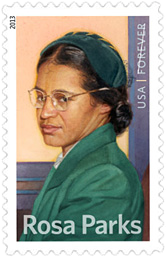 |
Rosa Parks The U.S. Postal Service honors Rosa Parks, who, in 1955 in Montgomery, Alabama, courageously refused to give up her seat on a municipal bus to a white man, defying the discriminatory laws of the time. The response to Parks' arrest was a boycott of the Montgomery bus system that lasted for more than a year. The many honors Parks received in her lifetime include the Presidential Medal of Freedom (1966), the Spingarn Medal (1979), and the Congressional Gold Medal (1999). Upon her death in 2005, she became the first woman and second African American to lie in honor in the U.S. Capitol Rotunda in Washington, DC. |
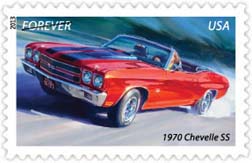 |
1970 Chevelle SS The first of five “Muscle Cars” stamps that are planned for 2013 is one featuring a 1970 Chevelle SS. With features like optional twin racing stripes, the 1970 Chevelle SS looked fierce. SS stood for Super Sport, a fitting designation for the car, which had serious power: a 396-cubic-inch engine or a 454-cubic-inch engine option in two versions, the 360-horsepower LS-5 and the 450-horsepower LS-6. For its sheer power, the latter has become legendary among car buffs. The LS-6-propelled 1970 Chevelle SS was lightning quick. It finished in the 13-second range in quarter-mile tests. Optional Cowl Induction, a flap on the bulged hood that allowed cold air to flow into the engine, added even more kick. In addition to its impressive road performance, the 1970 Chevelle SS was also known for its unique style. Available as a coupe or a convertible, the 1970 Chevelle SS featured a black grille and SS emblems on both the grille and the rear bumper. The Chevelle is one of five Muscle Cars stamps being issued in 2013, with an expected release during the Daytona 500 events in February. |
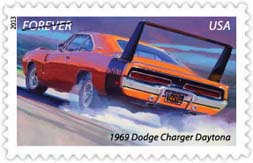 |
1969 Dodge Charger Daytona The outrageously styled 1969 Dodge Charger Daytona was designed to dominate on the racetrack. The car took the checkered flag at its NASCAR debut in September 1969 at Alabama International Motor Speedway in Talladega. The production version of the car was powered by a standard 440-cubic-inch, 375-horsepower Magnum engine. A limited number of Daytonas were also available with a 426-cubic-inch Hemi, a race-inspired engine Chrysler introduced earlier that decade. Concealed headlights, fender-mounted scoops, a nearly two-foot tall, rear-mounted wing, and an 18-inch nose piece helped boost aerodynamics. Other signature touches were thick body stripes containing the word “DAYTONA.” The distinctive vehicles were not easy to come by. In order to qualify for NASCAR racing, at least 500 Daytonas had to be made available for purchase; only 503 were produced. |
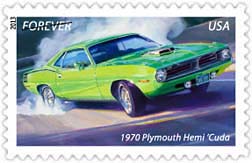 |
1970 Plymouth Hemi 'Cuda The third Muscle Car stamp announced by the USPS is the 1970 Plymouth Hemi 'Cuda, a performance-oriented version of the standard 1970 Plymouth Barracuda. The Cuda's 426-cubic-inch Hemi engine was a 425-horsepower beast. The car was part of what Plymouth called “The Rapid Transit System.” One of the 1970 Plymouth Hemi 'Cuda's more audacious features was a Shaker hood scoop, which vibrated as air flowed through to the engine's two four-barrel carburetors. The car was available in a variety of eye-popping color choices, such as Lemon Twist, Lime Light, and Vitamin C. Hockey-stick shaped stripes denoting engine size, a shifter handle shaped like a pistol grip, and bucket seats were also offered. The model is also a rare specimen: Fewer than 700 were produced. |
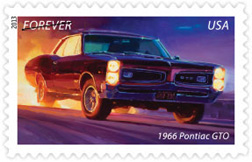 |
1966 Pontiac GTO The Pontiac GTO ushered in the American muscle-car era in the mid-1960s, just as the baby boomers began to come of age. The first GTO was born when engineers dropped a 389-cubic-inch V8 engine, which was built for a full-size sedan, into an intermediate-size Pontiac Tempest LeMans. Initially offered simply as an option on the Tempest LeMans, the GTO—which in Italian stood for Gran Turismo Omologato, or in English, Grand Touring Homologated—became its own model in 1966. Available as a hardtop, coupe, or convertible, the 1966 Pontiac GTO was equipped with a standard 335-horsepower V8 engine. The “Goat” could really move; in tests, it went from 0 to 60 miles per hour in 6.8 seconds. It also looked much different than its predecessors. Starting in 1966, the car featured curvy Coke-bottle styling and a split grille. That model year, sales of the distinctive GTO peaked. |
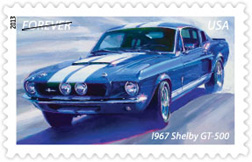 |
1967 Shelby GT-500 Manufacturer Carroll Shelby's take on the Ford Mustang reflected his roots as a racecar driver. The 1967 Shelby GT-500 was powered by a 428-cubic-inch, 355-horsepower Police Interceptor engine. The car also featured a rear spoiler and optional dealer-installed LeMans stripes. Rocker panel stripes came standard on the 1967 Shelby GT-500, which also sported grille-mounted headlights. A scooped fiberglass hood, extended nose, and interior roll bar and shoulder harnesses further enhanced the racecar feel. The 1967 Shelby GT-500 was more than just a racer. The improved suspension softened the ride, resulting in a vehicle that was comfortable to drive on the highway as well as on the track. The car was both striking and rare; only 2,048 were built. Rekindling American pop culture's fascination with the model, in 2007, Ford reintroduced the Shelby GT-500 into the Mustang model lineup. |
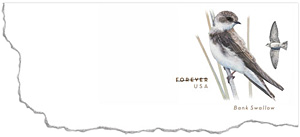 |
Bank Swallow Stamped Envelope The Bank Swallow, the smallest swallow in North America, is pictured on the Bank Swallow Stamped Envelope. The art shows a large illustration of the swallow perching and a smaller illustration of the bird in flight. The design is highly realistic, based on photographs, and has not been subjected to computer stylizing. Like all swallows, bank swallows are agile songbirds that specialize in catching insects in midair. They use their beaks and feet to dig burrows in sandy banks overlooking lakes and streams. A typical bank swallow colony can have anywhere from ten to nearly 2,000 nests. |
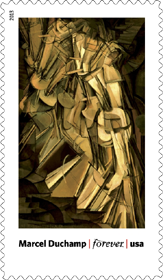 |
Modern Art in America, 1913 - 1931 [Click to see sheet] The U.S. Postal Service commemorates 12 important modern artists and their works 100 years after the groundbreaking Armory Show opened in New York in 1913. The masterpieces, all created between 1912 and 1931, are Stuart Davis's House and Street; Charles Demuth'sISaw the Figure 5 in Gold; Aaron Douglas' The Prodigal Son, Arthur Dove's Fog Horns, Marcel Duchamp's Nude Descending a Staircase, No. 2—shown here, the most talked-about work at the Armory Show of 1913—Marsden Hartley's Painting, Number 5, John Marin's Sunset, Maine Coast, Gerald Murphy's Razor, Georgia O'Keeffe's Black Mesa Landscape, New Mexico / Out Back of Marie's II, Man Ray's Noire et Blanche, Charles Sheeler's American Landscape, and Joseph Stella's Brooklyn Bridge. |
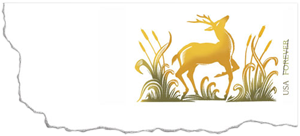 |
Deer Stamped Card The Deer Stamped Card is another of the 2013 releases that meet the new rates. The Forever® stamped card will always be equal to the value of the First-Class Mail postcard rate in effect at the time of use. A fanciful graphic of a golden deer, surrounded by gold and green cattails and grasses, captures the graceful look of an animal that is found in many countries around the world. The white-tailed deer is the most common species of deer in the United States. In the 1800s, people on the frontier fashioned deerskins into jackets, clothing, and moccasins, and even traded the skins, known as buckskins, as a form of currency. As a result, a dollar bill is known as a “buck” to this day. |
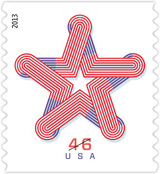 |
Patriotic Star The Patriotic Star stamp features a red, white, and blue five-pointed star on a white background. The star on the stamp is actually two stars—a smaller one inside a larger one. Both have five points, like the stars on the American flag. Created digitally by artist Nancy Stahl, the star is designed to look like it is crafted from striped ribbon. The star is one of the nation's most prominent symbols, a shining reminder of the indomitable spirit of the United States of America. This stamp is intended primarily for business use. It is being issued as a 46¢ First-Class Rate Large Coil stamp in coils of 3,000 and 10,000. |
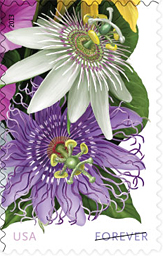 |
La Florida [Click to see 4 designs] This set of four stamps commemorates the 500th anniversary of the naming of Florida and celebrates the state's floral abundance. During the Easter season of 1513, Spanish explorers first visited the area and named it "La Florida" for Pascua Florida ("Feast of the Flowers"), Spain's Easter celebration, and for the verdant display of vegetation that they could see from their ship. Each stamp shows a particular variety of flower: red and pink hibiscus; yellow cannas; morning glories in white, red, and shades of purple; and white and purple passionflowers. The stamp pane, whose photo has not yet been released, includes on the selvage an imagined scene of explorers traveling in a small boat along a river or channel surrounded by tropical foliage.
|
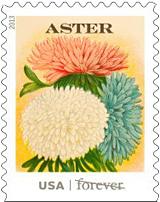 |
Vintage Seed Packets [Click to see sheet] Flowers being among the most popular subjects on stamps, the USPS offers a new take on the subject with Vintage Seed Packets. From hand-tinted lithographs in the early 1800s to modern photography, images of beautiful flowers have adorned seed packets for more than a hundred years. The stamp art for this issue features ten photographs of antique seed packets, printed between 1910 to 1920, cropped to focus on these flowers: cosmos, digitalis, pinks, primrose, calendula, aster, linum, alyssum, phlox, and zinnia. Above each illustration in bold capital letters is the name of the flower depicted. |
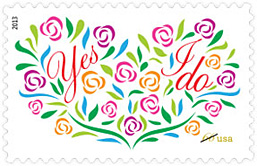 |
Yes I Do The Yes, I Do stamp is part of an ongoing series of issues that can be used to mail Wedding invitations. The 66¢ 2-ounce rate stamp can be used on the outer envelope, which contains the Wedding invitation, an RSVP card, and an RSVP envelope. Based on past experience a related design will be issued as a First Class rate stamp for the RSVP envelope. The Yes, I Do stamp is intended to add a festive, colorful flair to wedding correspondence, with the words “Yes, I Do” nestled in a bouquet of stylized flowers in the shape of a heart. |
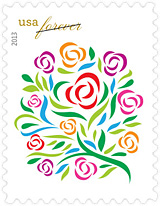 |
Where Dreams Blossom With a stylized bouquet of flowers similar to the design of the 2013 two-ounce Yes, I Do wedding stamp, the Postal Service has titled the one-ounce Weddings stamp Where Dreams Blossom. The stamp is being issued as a Forever stamp. While it is intended for use on save-the-date notices, response cards, and thank-you notes, it can be used on any one-ounce First Class letter rate mail. It will be issued in self-adhesive sheets of 20. Designed by art director Ethel Kessler, Where Dreams Blossom features the work of graphic artist Michael Osborne. |
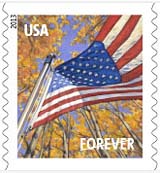 |
A Flag for All Seasons [Click to see 4 designs] In 2008 the USPS gave us the 24/7 Flags, showing Old Glory at four times throughout the day and night. Now they have announced that we will have four stamps showing the American Flag from the heights of sunny summer to the snowy depths of winter. Each of the four A Flag For All Seasons stamps shows an American flag, viewed from below, flying from a pole at full staff against a background of trees that evoke one of the four seasons of the year. The stamp art is the work of Laura Stutzman, who used her personal photographs of the flag as art reference. See May 17, August 8, or August 16, for other A Flag for All Seasons 2013 issues. |
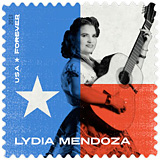 |
Lydia Mendoza (Music Icons) One of the first and greatest stars of Tejano music, Lydia Mendoza is seen strumming her 12-string guitar on this stamp, one of several that will be part of a Music Icons series. The square stamp is intended to capture the look of a vintage 45-rpm record sleeve, down to a slight weathering away of the colors. The stamp art features a black-and-white publicity photo of Mendoza taken in the 1950s, with the flag of Texas, Mendoza's home state, splashed across the photo. Nicknamed La Alondra de la Frontera, the Lark of the Border, Lydia Mendoza performed the Spanish-language music of the Texas-Mexico borderlands and beyond. Born into a musical family, Mendoza first performed with her mother, father, and sister in stores and restaurants. She recorded more than a thousand songs in a career that spanned seven decades. |
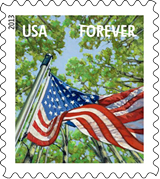 |
A Flag for All Seasons [Click to see 4 designs] In 2008 the USPS gave us the 24/7 Flags, showing Old Glory at four times throughout the day and night. Now they have announced that we will have four stamps showing the American Flag from the heights of sunny summer to the snowy depths of winter. Federal law states that the American flag should be displayed every day of the year, but especially on federal and state holidays, the ‘birthdays' of states, and other days according to presidential proclamation. As long as a flag is a durable, all-weather flag, it may be displayed outdoors throughout the year, regardless of the weather. See May 3, August 8, or August 16, for other A Flag for All Seasons 2013 issues. |
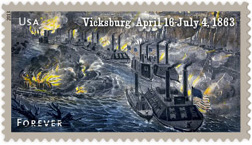 |
Civil War. 1863 [Click to see 2 stamp designs], [Souvenir Sheet] The third set in this annual series highlights the Battle of Gettysburg, the largest battle of the war, while the other depicts the Battle of Vicksburg, a complex Union campaign to gain control of the Mississippi River. The Battle of Gettysburg stamp is a reproduction of an 1887 chromolithograph by Thure de Thulstrup (1848-1930), a Swedish-born artist who became an illustrator for Harper's Weekly after the Civil War. Thulstrup's work was one of a series of popular prints commissioned in the 1880s by Boston publisher Louis Prang & Co. to commemorate the Civil War. The Battle of Vicksburg stamp is a reproduction of an 1863 lithograph by Currier & Ives titled “Admiral Porter's Fleet Running the Rebel Blockade of the Mississippi at Vicksburg, April 16th, 1863.” The souvenir sheet containing six of each stamp shows a photograph taken by Mathew Brady shortly after the Battle of Gettysburg of captured Confederate soldiers, who reportedly posed for Brady on Seminary Ridge. It also includes comments on the war by Abraham Lincoln, Clara Barton, Rufus R. Dawes (a Union soldier), and William Tunnard (a Confederate soldier) as well as some of the lyrics of “Lorena,” a popular Civil War song. |
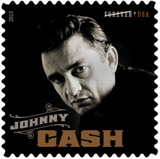 |
Johnny Cash (Music Icons) Johnny Cash (1932–2003) is best remembered internationally as a country music artist, his influence is felt from rock and folk to blues and gospel. His stamp is being issued this year as part of the exciting new Music Icons stamp series. Resembling the appearance of a 45 rpm record sleeve, the square stamp features a photograph during the photo session for Ring of Fire: The Best of Johnny Cash (1963). Cash found inspiration for his music in the stories of outlaws and laborers, and in his own life experience. A child of the Depression, he grew up in rural Arkansas, and the culture of that time and place—especially the Bible and gospel and country music—remained with him all his life. By the 1960s, Cash had become one of the top names in country music and won several Grammy awards. He was inducted into the Country Music Hall of Fame in 1980 and the Rock and Roll Hall of Fame in 1992. |
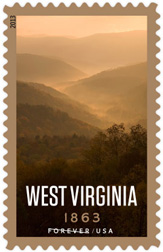 |
West Virginia Statehood Admitted to the Union on June 20, 1863, in the midst of the Civil War, West Virginia is one of only two new states created during the war and the only one created by separation from a Confederate state. Located entirely within the Appalachian Highlands, West Virginia is now known as the Mountain State. Its official motto reflects the realities of topography as well as its individualistic spirit: montani semper liberi , “mountaineers are always free.” Celebrating 150 years of statehood, the stamp features a photograph by West Virginia photographer Roger Spencer showing an early morning view looking east from the Highland Scenic Highway (Route 150) in Pocahontas County, West Virginia, within Monongahela National Forest. Coal mining as well as natural gas and oil are important West Virginia industries. Tourism also is being promoted using the state slogan, “Wild and Wonderful.” |
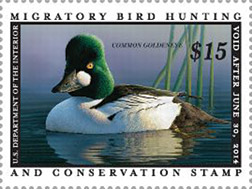 |
Federal Duck Stamp (not a postage stamp) The 2013-2014 Duck stamp features Robert Steiner's acrylic painting of a common goldeneye. Duck stamps are not postage stamps. The Fish and Wildlife Service produces the Federal Duck Stamp, which raises about $25 million each year to provide critical funds for conserving wetlands for the benefit of wildlife and the enjoyment of people. The new stamp is valid from July 1, 2013 through June 30, 2014. It is required by waterfowl hunters age 16 and older and also is purchased by conservations and collectors. |
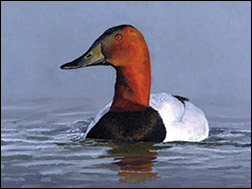 |
Junior Duck Stamp (not a postage stamp) The Junior Duck stamp pictures 6-year-old Madison Grimm's painting of a canvasback duck. After being announced as the winner, the award was taken away from Madison because it was felt that a 6-year-old could not have produced this design. After protests from Madison's father, duck stamp artist Adam Grimm, and others, the award to Madison was reinstated. The Junior Duck stamp is not a postage stamp or a license. The Junior Duck Stamp Conservation and Design Program is a dynamic, art and science program designed to teach wetlands habitat and waterfowl conservation to students in kindergarten through high school and help reconnect youth with the outdoors. |
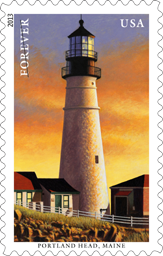 |
New England Coastal Lighthouses [Click to see 5 designs] Capitalizing on one of its more popular themes, in 2013 the U.S. Postal Service will add New England Coastal Lighthouses to its previous Lighthouses issues. The new set features the lighthouses at Portland Head, Maine; Portsmouth Harbor, New Hampshire; Point Judith, Rhode Island; New London Harbor, Connecticut; and Boston Harbor, Massachusetts. These five lighthouses are among the oldest in the U.S., and each is on the Click here for USPS Provides Lighthouses Details [PDF Document] |
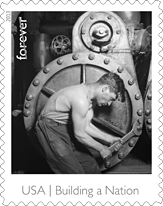 |
Made in America: Building a Nation [Click to see all 5 panes: “The Made in America: Building a Nation stamps honor the courageous workers who helped build the United States.” With those words, the Postal People announced an ambitious program offering 12 different stamps featured in five different pictorial margin panes. In the top row are an airplane maker, a derrick man on the Empire State Building, a millinery apprentice, and a man on a hoisting ball on the Empire State Building. In the middle row are a linotyper in a publishing house, a welder on the Empire State Building, a coal miner, and riveters on the Empire State Building. In the bottom row are a powerhouse mechanic, a railroad track walker, a textile worker, and a man guiding a beam on the Empire State Building. The five different sheets each have a different selvage photograph: two with Empire State Building iron workers, another with a General Electric worker measuring the bearings in a huge casting, the fourth uses the same image of the coal miner that appears in the stamp pane, and the final margin depicts a female welder. |
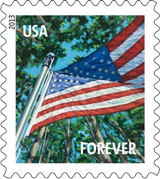 |
A Flag for All Seasons [Click to see 4 designs] The A Flag for All Seasons set of four stamps shows the American Flag at various times of the year, with each season indicated by the trees in the background. Federal law states that the American flag should be displayed every day of the year. As long as a flag is a durable, all-weather flag, it may be displayed outdoors throughout the year, regardless of the weather. See May 3, May 17, or August 16, for other A Flag for All Seasons 2013 issues. |
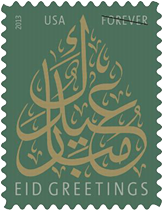 |
Eid Festivals The Eid stamp celebrates the two most important festivals—or eids—in the Islamic calendar: Eid al-Fitr and Eid al-Adha. On these days, Muslims wish each other Eid Mubarak, the phrase shown in calligraphy on the stamp. Eid Mubarak translates literally as “blessed festival” and can be paraphrased “May your religious holiday be blessed.” |
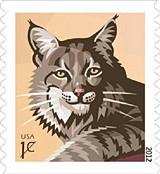 |
Bobcat This is a water activated gum variety of the pressure sensitive adhesive stamp that was issued last June 1. The bobcat has been pictured previously on U.S. stamps: in 1987 on a 22¢ North American Wildlife issue and in 1990 on a $2 Flora and Fauna definitives issue. Nancy Stahl worked with art director Carl T. Herrman on this latest, highly stylized, design. The bobcat traces back to around 1.8 million years ago. It ranges from southern Canada to northern Mexico, including most of the continental U.S. About twice as large as the domestic cat, it has distinctive black bars on its forelegs and a black-tipped, stubby tail, from which it derives its name. |
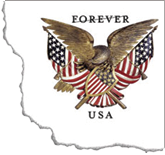 |
Eagle Folk Art Stamped Envelope The United States has a long tradition of depicting eagles on postage stamps, starting with the 10¢ and 30¢ stamps in the 1869 Pictorial Issue and continuing through to this latest version, a stamped envelope that features an eagle carrying two American flags and a shield. Whether shown on the Great Seal of the United States, portrayed majestically in flight, or seen while perched atop a mountain ledge, the eagle has long been associated with patriotism. Since its adoption as the national symbol of the United States in 1782, countless artists and artisans have worked eagle motifs into paintings, pottery, furniture, courthouse decorations, quilt patterns, wood carvings, weather vanes, and other functional and decorative objects. The new stamped envelope design is based on a plaque by an unknown carver. |
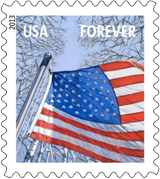 |
Flag for All Seasons [Click to see 4 designs] The A Flag for All Seasons set of four stamps shows the American Flag at various times of the year, with each season indicated by the trees in the background. Federal law states that the American flag should be displayed every day of the year. As long as a flag is a durable, all-weather flag, it may be displayed outdoors throughout the year, regardless of the weather. See May 3, May 17, or August 8, for other A Flag for All Seasons 2013 issues. |
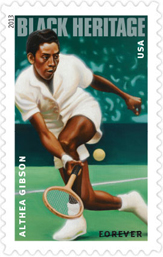 |
Althea Gibson The 36th stamp in the Black Heritage series honors Althea Gibson (1927–2003), a pioneering tennis player who became the first black Wimbledon champion. Relying on a booming serve and precise volley, Gibson blazed a trail for a future generation of African-American tennis players. The first black tennis player to win one of the four major singles tournaments, Gibson helped integrate her sport at the height of the civil rights movement. The oil-on-wood painting featured on the stamp is based on a photograph—taken at Wimbledon—of Gibson bending down to hit a low volley. She twice won Wimbledon and the U.S. Championships (now known as the U.S. Open) and became the top-ranked player in the world. |
 |
March on Washington Rep. John Lewis, the last surviving speaker at the March, led a host of dignitaries in officially dedicating the stamp and underscoring the importance of the historic 1963 event. The brainchild of labor leader A. Philip Randolph, a veteran of battles against racial discrimination, the event drew nearly a quarter of a million people to participate in the March on Washington for Jobs and Freedom. It was then that Dr. Martin Luther King, Jr., delivered his powerful “I Have a Dream” speech on the steps of the For the first time, the Postal Service unveiled the stamp artwork via the USPS' Stamps Facebook page. During the August 23 First Day ceremony in Washington, D.C., actress Gabrielle Union added her photo to the mosaic to reveal the final piece of the 1963 March on Washington stamp. |
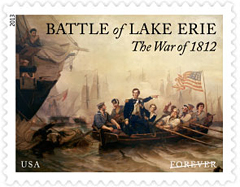 |
The War of 1812: The Battle of Lake Erie The USPS continues its multi-year series for events of the War of 1812 with a stamp commemorating the Battle of Lake Erie, which took place on September 10, 1813. The stamp depicts Oliver Hazard Perry in the small boat he used to transfer from his ruined flagship, the Lawrence, to the Niagara. After boarding and taking command of the Niagara, Perry attacked and demolished the British ships Detroit and Queen Charlotte. He then penned one of the most memorable phrases of the war in a report to General William Henry Harrison: “We have met the enemy and they are ours.” Perry's triumph gave the U.S. control of Lake Erie and allowed the army to recover ground lost early in the war. The British and their Indian allies abandoned their outposts on the Detroit frontier and retreated up the Thames River deeper into Upper Canada. General Harrison pursued them and won the Battle of the Thames on October 5, 1813, less than a month after Perry's victory. It was on September 10, 1813 that Perry departed from Put-in-Bay for his decisive victory. |
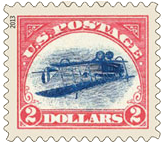 |
Inverted Jenny [Click to see sheet] This souvenir sheet features a new version of the world-famous Inverted Jenny error. The sheet includes six Inverted Jenny stamps, reprinted with an updated denomination and surrounded by an illustration that includes the National Postal Museum in Washington, D.C.; the route of the first regularly scheduled airmail service between Washington, Philadelphia, and New York; and aviation pioneer Reuben H. Fleet, who was in charge of the first group of airmail pilots. Originally issued on May 14, 1918, to commemorate the start of the first regular airmail service the following day, the stamp features a Curtiss JN-4H, or “Jenny,” the biplane used to deliver the mail. One sheet of 100 stamps that mistakenly showed the biplane upside down was sold on the first day of sale to a collector in Washington, D.C.—and one of the greatest philatelic treasures in U.S. history was released into the world. The new Inverted Jenny stamp is being reprinted with a $2 denomination to make it easily distinguishable from the 24-cent 1918 original. The souvenir sheet will be issued in conjunction with the opening of the William H. Gross Stamp Gallery at the National Postal Museum. |
 |
Un-Inverted Jenny [Click to see sheet] In addition to the 2,200,000 Inverted Jenny souvenir sheets, the USPS created 100 ‘cracker jack prize' souvenir sheets with the plane right side up. These were mixed in with the full run of Invert sheets so that people who buy that souvenir sheet might ‘win a prize' Un-Inverted sheet. |
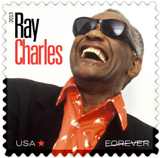 |
Ray Charles (Music Icons) With this stamp in its new Music Icons series the U.S. Postal Service honors musician Ray Charles. An extraordinary composer, singer, and pianist, blind since childhood, Ray Charles blended blues, gospel, country, jazz, and soul music in a highly influential pop music style. His work spanned almost the entire breadth of American music and brought him 17 Grammy Awards, plus an award for lifetime achievement in 1987. His many other prizes include the National Medal of Arts, awarded in 1993, and the Kennedy Center Honors in 1986. That same year, he was inducted into the Rock and Roll Hall of Fame. He performed at the White House many times for several different presidents. The stamp art features an image of Charles, taken later in his career. As with the other Music Icons issues, the stamp sheet will have the appearance of a 45 rpm single peeking out of a record sleeve above the stamps themselves. |
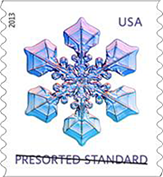 |
Snowflakes Presort Standard Rate Holiday Stamps [Click to see 4 designs] One of the new entries in the annual USPS Holiday issues rollout is a set of five different Presorted Standard rate Snowflake stamps. Each snowflake is set against a background of colors that fade from white at the bottom to icy blues and purples at the tops. The designs are reminiscent of the 2005 Snowflakes Holiday First Class stamps. Presort Standard Rate stamps are intended for use by volume mailers who have found that mail with a postage stamp affixed instead of a printed indicia has a better chance of being opened by the recipient. |
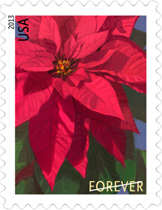 |
Poinsettia Contemporary Christmas Stamp The U.S. Postal Service continues its tradition of issuing Contemporary holiday stamps with a bright rendering of America's favorite holiday flower, the poinsettia. The stamp art depicts the rich red and vibrant green leaves surrounding the flower—the cluster of small, rather modest cup-shaped structures in the center. The red “petals” that we think of as the flower are actually modified leaves called bracts. A potted poinsettia was used as art reference. While considered by the ancient Aztecs to be a symbol of purity, the poinsettia today symbolizes good cheer. The gift of a poinsettia is said to bring with it wishes of laughter and celebration. William Low painted the stamp art. Ethel Kessler was the art director. |
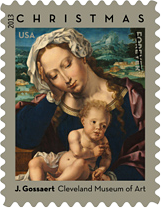 |
Virgin and Child Traditional Christmas Stamp The 2013 Traditional Christmas stamp uses a 1531 Madonna and Child painting by Jan Gossaert. Draped in purple and blue, the Virgin Mary supports her own head by leaning on one of her hands, an unusual pose that art historians see as a sign of sadness and contemplation. In her other hand, a curly-haired infant Jesus draped in white holds a bunch of red currants, which scholars believe are meant to foreshadow his future suffering. Gossaert's painting is currently in the collection of the Cleveland Museum of Art. Richard Sheaff was the art director and designer for this stamp. |
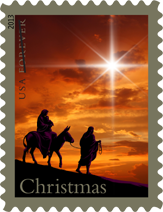 |
Christmas Traditional: Holy Family A re-issue of the 2012 stamp, art director William J. Gicker, designer Greg Breeding, and artist Nancy Stahl created a design that depicts a scene from the Nativity story. A journey that is described in the second chapter of the Gospel according to Matthew, the design shows Joseph leading a donkey that carries Mary and Jesus, guided by a star shining in the twilight of a desert sky. |
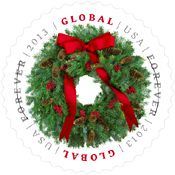 |
International Christmas Evergreen Wreath Stamp A new entry in the annual USPS Holiday issues rollout is a Global Forever stamp that depicts an Evergreen Wreath. This international rate stamp offers a single price for any First-Class Mail International one-ounce letter to any country in the world or for a 2-ounce letter to Canada. To distinguish it from domestic rate Forever stamps, it is round and bears the words “Global Forever.” The wreath that graces the stamp art has a base made of a wire metal frame folded around Styrofoam, which was spray-painted green. The designer attached evergreen twigs onto picks and inserted them into the base, rotating the picks to make the wreath full and lush. The decorations are clusters of bright red Nandina berries and pinecones. The wreath is finished with a traditional red bow. |
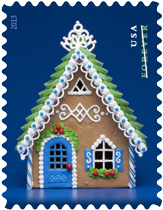 |
Gingerbread Houses Contemporary Christmas Stamps [Click to see 4 designs] In addition to the Poinsettia Contemporary Christmas stamp, the USPS also presents a set of four cheerful gingerbread houses. Stumbling across a magical cottage made of cake and candy, adding a touch of nostalgia to holiday mail. The colorful gingerbread houses stand out against a bright blue background. Made with gingerbread and royal icing, each house has sugary fruit slices for shingles, peppermint sticks for support beams, and round, candy-coated chocolate for doorknobs and holly berries. Sally Andersen-Bruce photographed the houses, created by baker Teresa Layman. Art director Derry Noyes designed the stamps. |
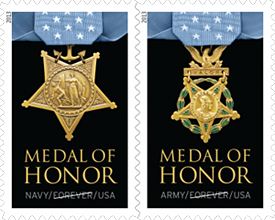 |
Medal of Honor For this issue, the USPS introduces a new format, the prestige folio. The first side of this four-page folio highlights historical photographs of the last ten living recipients of the Medal of Honor from World War II. (Two of the recipients, Senator Daniel K. Inouye and Vernon McGarity, died before the stamps could be issued, but their photos also are included.) The 12 photographs surround two Forever stamps. One stamp features a photograph of the Navy version of the Medal of Honor; the other stamp features a photograph of the Army version. The remaining 18 stamps are found on the back page of the folio. The two center pages list the names of all 464 recipients of the Medal of Honor from World War II. |
|
Harry Potter Stamp Collection [Click here for Harry Potter front cover] The Harry Potter set of 20 stamps was issued at Universal Orlando Resort's Wizarding World of Harry Potter. Folded out, the booklet cover presents an illustration of Hogwarts castle. Inside are five groupings of four stamps. Each grouping is set on its own page and each set of four stamps surrounds the red wax seal of Hogwarts School of Witchcraft and Wizardry. The stamps feature scenes from Warner Bros.' Harry Potter films, which brought author J.K. Rowling's magical world to the screen and gave physical shape to the characters, creatures and places that had lived in readers' imaginations since publication of the first book. Described as a Limited Edition, demand is expected to be strong, so a total of 5 million booklets were issued. |
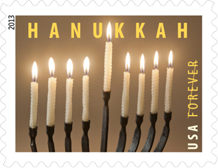 |
Hanukkah The 2013 stamp depicts a hanukiah, the nine-branched menorah used during Hanukkah. Eight of its branches represent each of the eight nights and days of Hanukkah, and the ninth, the shamash or “the servant,” is used to light the other candles. The stamp art is a photograph of a contemporary forged-iron hanukiah created by Vermont blacksmith Steven Bronstein. Hanukkah is the Hebrew word for “dedication.” Tradition relates how a miracle took place during the rededication of the Temple in Jerusalem, which had been desecrated. The sacramental oil, thought to be enough for only one day, burned for eight days. The miracle of the oil is at the heart of the ritual of the lighting of the hanukiah. In 2013, Hanukkah begins at sundown on November 27. |
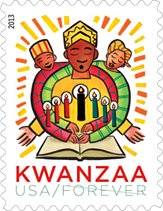 |
Kwanzaa Created in 1966, Kwanzaa draws on African traditions, deriving its name from the phrase “first fruits” in Swahili. It is a non-religious holiday that takes place over seven days from December 26 to January 1, and brings family, community, and culture together for many African-Americans. The stamp art features a man, woman, and child dressed in traditional, African-inspired clothing joined together in a unifying embrace. Their intertwined arms form a circle around seven candles, known as the mishumaa saba—a centerpiece of the Kwanzaa table. An open book symbolizes the holiday's emphasis on knowledge and cultural history. |
| Stamp images provided by the United States Postal Service. Copyright © 2013 USPS. All Rights Reserved. |
|
| Stamp News Now . 42 Sentry Way . Merrimack, NH 03054 . Call Free: 603-424-7556 . Email: [email protected] ©2025 Stamp News Now, All Rights Reserved |

